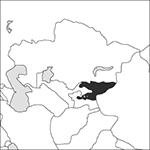
Source: MAPS IN MINUTES™ © RH Publications (1997)
Capital:
Bishkek
Area:
199,951 sq km (77,202 sq miles)
Population:
5,548,042 (2013 est)
Currency:
1 som=100 tyiyn
Religions:
Muslim 75.0%; Eastern Orthodox 20.0%
Ethnic Groups:
Kirghiz 64.9%; Uzbek 13.8%; Russian 12.5%
Languages:
Kirghiz, Russian (both official); Uzbek; minority languages
International Organizations:
OSCE; UN; Commonwealth of Independent States; Euro-Atlantic Partnership Council; WTO
A country in central Asia bounded by Kazakhstan on the north and north-west, Uzbekistan on the south-west, and Tajikistan on the south.
Physical
On the south-east the Tian Shan range of mountains, which rise to 7439 m (24,406 feet), span the border with China. Kyrgyzstan is a mountainous country with many snowfields, glaciers, and deep lakes. Its lower plains are exposed to hot desert winds. Its middle reaches are forested, while the lower slopes provide pasture for millions of sheep.
Economy
Agriculture, the dominant economic activity, is based on livestock-raising and crops such as tobacco, cotton, vegetables, fruit, and berries. Kyrgyzstan has substantial mineral reserves, including gold and coal. Gold is the leading export, followed by cotton, wool, clothing, meat and tobacco. Remittances from expatriates are vital to the economy.
History
Absorbed into the Russian empire during the 19th century, Kyrgyzstan became an autonomous province of the Soviet Union in 1924 and the Kirghiz Soviet Socialist Republic in 1936. In 1990 Askar Akayev, a supporter of reforms and of independence for Kyrgyzstan, was elected President. He survived an attempted coup in 1991 and resigned from the Communist Party of the Soviet Union. The Kirghiz Communist Party then dissolved itself and the country became independent as Kyrgyzstan. New constitutions were adopted in 1993 and 1994 and the first multiparty elections were held in 1995. Akayev remained President and continued to introduce economic reforms; however, in 2005 he was forced out of office by popular demonstrations after disputed parliamentary elections. Kurmanbek Bakiyev, the leader of the opposition, was elected President by a large majority. He pursued increasingly authoritarian policies, and his apparent landslide victory in the 2009 presidential election was disputed. In 2010 he was overthrown following protests against rising prices; the subsequent instability featured Kirghiz–Uzbek ethnic violence in the south of the country. A new constitution was introduced, and the pro-Russian social democrat Almazbek Atambayev was elected President in 2011. He refused to extend the lease on a US airbase used to supply Afghanistan and in 2015 led Kyrgyzstan into the new Eurasian Economic Union. Atambayev’s Social Democratic Party won the most seats in the 2015 election and currently leads a four-party coalition . The 2017 presidential election resulted in victory for the Prime Minister, Sooronbay Jeenbekov.
- liquation
- liquefaction
- liquefaction of gases
- liquefied natural gas
- liquefied petroleum gas
- liquefied refinery gas
- liquid
- liquid assets
- liquidation
- liquid cooling garment
- liquid crystal
- liquid-crystal display
- liquid crystal on silicon
- liquid-crystal polymer
- liquid distributor
- liquid-drop model
- liquid-encapsulated Czochralski
- liquid fuel
- liquidity
- liquidity constraint
- liquidity preference
- liquidity ratio
- liquidity risk
- liquidity trap
- liquid limit